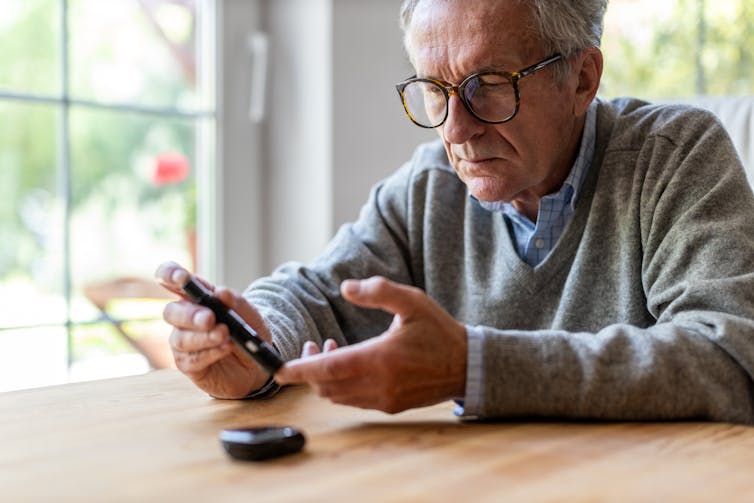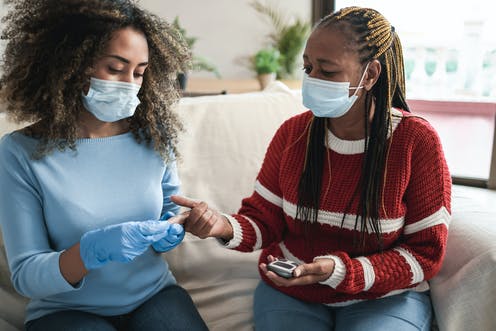DisobeyArt/Shutterstock
Many people who have had COVID-19 have gone on to develop diabetes. But diabetes is relatively common, and COVID is too, so that doesn’t necessarily mean one leads to the other.
The question is whether people who have had COVID are more likely to develop diabetes than those who haven’t. And if so, is it COVID that’s causing diabetes, or is there something else that links the two?
Recent studies suggest there is an association between having COVID and going on to be diagnosed with diabetes. US data, based on records of more than 500,000 people aged under 18 who had COVID, found these young people were more likely to receive a new diabetes diagnosis following their infection, compared to those who didn’t have COVID and those who’d had other respiratory infections prior to the pandemic. The study didn’t specify which types of diabetes people developed.
Another US study in an older age group found the same patterns in their analysis of over four million patients. In this case, most of the diabetes cases were type 2.
A German study based on medical records of more than eight million patients again found people who had COVID were more likely to subsequently be diagnosed with type 2 diabetes.
À lire aussi :
Do you get diabetes from eating too much sugar?
Remind me, what is diabetes?
There are various different kinds of diabetes. What they all have in common is that they affect the body’s ability to produce or respond to the hormone insulin. Insulin controls the amount of sugar in our blood, so if we don’t produce enough of it, or it’s not working properly, our blood sugar goes up.
The most common type of diabetes by far is type 2 diabetes. It often comes on in adulthood and is characterised by insulin resistance. In other words, people with type 2 diabetes are still producing insulin, but the insulin isn’t working properly. Treatments vary and include medication, changes to diet, and increased physical activity.
The next most common is type 1. Type 1 diabetes often, but not always, comes on in childhood or adolescence. I was diagnosed at the age of ten. In type 1 diabetes, the body stops producing insulin altogether. People with type 1 diabetes need to take injections or infusions of insulin for the rest of their lives.
So how could COVID cause diabetes?
There are many plausible theories about how COVID might cause diabetes, but none have been proven. One possibility is that inflammation caused by the virus could bring about insulin resistance, which is a feature of type 2 diabetes.
Another possibility relates to ACE2, a protein found on the surface of cells, which SARS-CoV-2 (the virus that causes COVID-19) attaches to. Some studies have shown that the coronavirus can enter and infect insulin-producing cells via ACE2, which might cause the cells to die or change how they work. This could mean people are not able to produce enough insulin, leading to diabetes.

pikselstock/Shutterstock
In type 1 diabetes, the immune system attacks insulin-producing cells, but we don’t know why. One theory is that the immune system is triggered by something else – say, a virus – and then accidentally also attacks insulin-producing cells. It could be that COVID is causing some people’s immune systems to do just this.
Not so fast
Just because it appears people who have had COVID are more likely to develop diabetes, and there are plausible theories to explain this, it still doesn’t necessarily mean COVID causes diabetes.
It could be that COVID is causing temporary rises in blood sugar, that then resolve over time. A US study of 594 people newly diagnosed with diabetes while hospitalised with COVID found that blood sugar levels often returned to normal after discharge from hospital, without treatment.
We also know that dexamethasone – a steroid used to treat people with severe COVID – causes temporary rises in blood sugar.
Some scientists have questioned whether COVID is causing a new type of diabetes altogether, or whether people are being mistakenly classified as having diabetes after COVID.
À lire aussi :
ACE2: the molecule that helps coronavirus invade your cells
Further, a lot of diabetes tends to go undetected, especially type 2. It could be that people who are diagnosed with diabetes after having COVID actually had diabetes before getting COVID, but that the diabetes wasn’t picked up until they were being treated for COVID.
Rising levels of diabetes could also reflect an impact of pandemic restrictions, or changed behaviour as a result of infection or fear of infection, including delayed medical care and changes in diet and physical activity levels.
The four Ts
Type 2 diabetes tends to develop slowly over time, and even type 1 diabetes can take months to years to show up. So it’s likely to be some time before anyone can say definitively if COVID is leading to an increase in diabetes.
Regardless, it’s really important that people be aware of the signs and symptoms of this condition. Diabetes UK tells us to look out for the four Ts: toilet (going to the toilet a lot or wetting the bed), being thirsty, tired, and thinner. These are typical symptoms of type 1 diabetes. For type 2, a lot of people don’t get symptoms, or don’t notice them. However, the four Ts still apply, with blurred vision and general itching or thrush also listed as symptoms.
If you suspect you or a family member may have diabetes, don’t delay seeking medical attention. A quick finger prick test by a healthcare provider can determine immediately if your blood sugar is high, and whether further investigations might be needed.
![]()
Jamie Hartmann-Boyce has received funding from the National Institute for Health Research, Cancer Research UK, the British Heart Foundation, and the World Health Organization. The views and opinions expressed here are her own and do not necessarily reflect those of the her funders, the National Health Service (NHS) or the Department of Health.











